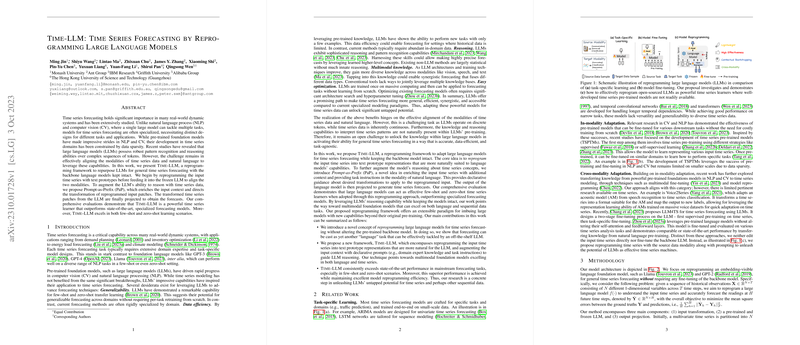Time-LLM: Time Series Forecasting by Reprogramming LLMs
The research introduces Time-LLM, a framework aimed at repurposing LLMs for time series forecasting. Traditionally, the domains of NLP and CV have benefited from versatile foundation models capable of addressing multiple tasks. However, time series forecasting has generally required specialized models due to data sparsity and the inherent nature of the data, which is continuous rather than discrete. This paper explores the potential of leveraging the capabilities of LLMs to generalize across various time series forecasting tasks.
Methodology Overview
Time-LLM operates by employing a reprogramming framework that maintains the backbone LLM in its original, unmodified state. It addresses the challenge of modality alignment between time series data and natural language by embedding the time series into text prototype representations. These representations are more intuitive for LLMs, thus enabling the model to reason about the time-dependent data effectively.
The core components of the framework include:
- Input Transformation: Time series data is tokenized into patches, which are then embedded using text prototypes to bridge the gap between continuous time series data and the discrete nature of LLM inputs.
- Prompt-as-Prefix (PaP): To enrich the context and improve reasoning capabilities, prompts are used to guide the transformation process. These prompts incorporate domain knowledge and instructions to support the LLM in processing patch representations.
- Output Projection: The LLM's output, refined through prompt context and reprogrammed patch embeddings, is projected to generate the forecast.
Numerical Results and Implications
The paper reports that Time-LLM outperforms state-of-the-art time series models across multiple datasets, including ETTh1, ETTh2, ETTm1, and ETTm2. It excels particularly in few-shot and zero-shot learning scenarios, showcasing the LLM's strong generalization capabilities when effectively reprogrammed.
These results suggest that LLMs, with minimal adjustments, can be adapted to processes outside their primary domain of language, indicating their potential as effective sequential data learners. The approach not only achieves notable efficiency in model reprogramming but also points towards the future integration of multimodal models that can seamlessly switch between language processing, vision tasks, and time series forecasting.
Theoretical and Practical Implications
Theoretically, Time-LLM advances the understanding of cross-modality adaptation, emphasizing the versatility of LLMs beyond traditional language tasks. The success of reprogramming offers insights into constructing general-purpose models capable of handling a broader range of sequential data tasks.
Practically, this research could lead to significant efficiency improvements in industries relying on time series forecasting, such as finance, climate modeling, and supply chain management. By leveraging existing LLMs, businesses can reduce the need for developing specialized models, thus saving on computational resources and time.
Future Directions
Future work in this area might explore:
- Further optimization of reprogramming representations to improve efficiency and accuracy.
- Expansion to include multimodal datasets, thereby enhancing the model's generalization capabilities across even more diverse tasks.
- Investigating the potential of continuous pre-training to imbue LLMs with explicit time series pattern recognition, enhancing their reasoning abilities further.
In conclusion, Time-LLM represents a promising paradigm shift in time series forecasting through the innovative reprogramming of LLMs, demonstrating their latent potential for broad-spectrum sequential learning. This research opens doors to more flexible and adaptable forecasting solutions, potentially transforming the landscape of AI applications in time-dependent data domains.
